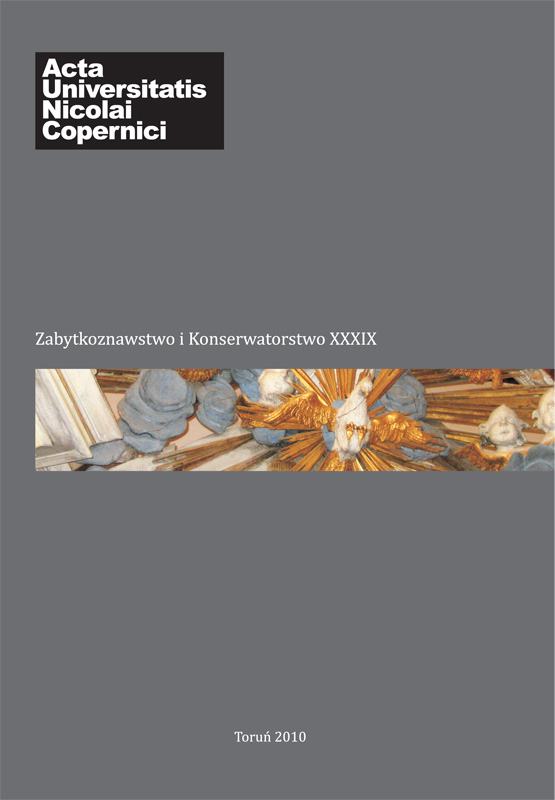Badania nad technologią zapraw imitujących kamienie naturalne Gotland i Obernkirchen
DOI:
https://doi.org/10.12775/AUNC_ZiK.2010.011Abstrakt
The Department of Conservation of Architectonic Elements and Details, Institute for the Study, Conservation and Restoration of Cultural Heritage NCU in Toruń, working on commission of Deutsches Bergbau -Museum Zollern-Institut in Bochum (Germany) carried out research, that aimed for developing the technology of mortars, characterising with physical and chemical properties matching those of Gotland and Obernkirchen sandstones.
In the research mineral binders were used (Portland cements, hydratised and disperged lime) as well as organic ones (epoxy resin and polymethyl metacrylate). From among the aggregates the glass-makers’ sand and ground sandstones were selected. The mortars were modifi ed with addition of metakaolinite, colloidal silica, quartz and marble powder. Changing the proportion of the aggregates and binders and adding various amounts of modifying substances one tried to obtain mortars of the properties described above.
The criteria, that have been taken into consideration in the fi rst place, were the capillary properties and compression resistance. If the mortars are to perform their protective function, their mechanical resistance should not exceed the resistance of sandstones, however it should guarantee their resistance to changing weather conditions (water, temperature).
From among numerous mortars with mineral binders that were tested, the postulated properties demonstrated cement mortars with sand (1:4 and 1:5), cement mortars with sand and colloidal silica (1:4:0,025), cement mortars with sand and hydratised lime (1:4:1), cement mortars with sand and quartz powder 40 μm (1:7:1 and 1:6,5:1,5). The last ones seem to be the most promising.
Taking into consideration the properties of mortars containing polymethyl metacrylate as a binder and sand as an aggregate one can propose their use (1:15) for fi lling cracks and crevices as well as for fi lling small, shallow injuries in the discussed sandstones. They have good adhesion and cure in layers of any thickness.
However, taking into consideration capillary properties, high porosity and absorbability of epoxy-resin mortars (resin:sand = from 1:20 to 1:30) one can postulate their application as desalinating plasters, particularly in cases, where the use of water-free materials is more appropriate (highly salinated artefacts, its susceptibility to water).
Both the polymethyl metacrylate and epoxy-resin mortars display – thanks to the addition of colloidal silica – very good hydrophilic properties and capillary absorb water much faster, than the examined sandstones.
Pobrania
Opublikowane
Jak cytować
Numer
Dział
Licencja
CC BY ND 4.0. Posiadaczem prawa autorskiego (Licencjodawcą) jest Autor, który na mocy umowy licencyjnej udziela nieodpłatnie prawa do eksploatacji dzieła na polach wskazanych w umowie.
- Licencjodawca udziela Licencjobiorcy licencji niewyłącznej na korzystanie z Utworu/przedmiotu prawa pokrewnego w następujących polach eksploatacji: a) utrwalanie Utworu/przedmiotu prawa pokrewnego; b) reprodukowanie (zwielokrotnienie) Utworu/przedmiotu prawa pokrewnego drukiem i techniką cyfrową (e-book, audiobook); c) wprowadzania do obrotu egzemplarzy zwielokrotnionego Utworu/przedmiotu prawa pokrewnego; d) wprowadzenie Utworu/przedmiotu prawa pokrewnego do pamięci komputera; e) rozpowszechnianie utworu w wersji elektronicznej w formule open access na licencji Creative Commons (CC BY-ND 3.0) poprzez platformę cyfrową Wydawnictwa Naukowego UMK oraz repozytorium UMK.
- Korzystanie przez Licencjobiorcę z utrwalonego Utworu ww. polach nie jest ograniczone czasowo ilościowo i terytorialnie.
- Licencjodawca udziela Licencjobiorcy licencji do Utworu/przedmiotu prawa pokrewnego nieodpłatnie na czas nieokreślony
PEŁEN TEKST UMOWY LICENCYJNEJ >>
Statystyki
Liczba wyświetleń i pobrań: 1534
Liczba cytowań: 0



